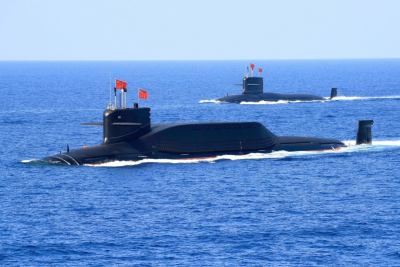China’s nuclear ballistic missile submarines (SSBN) are now prowling the South China Sea round-the-clock, ensuring a second-strike capability against US and allied forces in the event of a Taiwan contingency.
This week, Reuters reported that China is now keeping at least one nuclear-powered ballistic missile submarine (SSBN) at sea at all times, potentially stretching US defenses, putting more targets at risk, and pressuring the US and its allies to develop new capabilities to counter the threat.
China’s six Type 094 SSBNs are now operating near-continuous patrols from Hainan to the South China Sea and are reportedly armed with a new longer-ranged submarine-launched ballistic missile (SLBM) that can hit the US mainland.
The Reuters report notes that this new missile is believed to be the JL-3, which reportedly has a 10,000-kilometer range and allows China to hit the continental US from protected bastions in the South China Sea.
Previously, China’s Type 094 SSBNs, armed with the JL-2 SLBM missile, needed to launch from the Western Pacific and east of Hawaii to hit the US mainland. That entailed traversing maritime chokepoints such as the Miyako Strait, Bashi Channel and Sulu Sea, making the SSBNs vulnerable to interception by US and allied naval forces.
Reuters mentions that this new development shows China’s rapid improvement in logistics, command and control and weapons to maintain a sea-based nuclear deterrent. The report also states that China is starting to deploy its SSBNs similar to the way nuclear powers like the US, UK, France and Russia do.
Reuters says this development will require US nuclear attack submarines (SSN) to shadow China’s SSBNs, stretching already limited submarine inventories and strained shipbuilding capabilities while running the risk of nuclear escalation.

This February, Asia Times noted that each of China’s 13 naval shipyards has more capacity than all seven US naval shipyards combined, placing the US at a seeming loss against China’s ascendant shipbuilding capabilities. Budget cuts and other issues have recently seen US naval shipyards lay off skilled workers, causing US warships to linger longer in shipyards for repairs.
Asia Times noted last November that China’s SSBNs are essential for its second-strike nuclear capability, with fleet upgrades allowing China to be more confident of its “no-first-use” nuclear policy. This ties in with China’s nuclear force structure, which is designed to withstand an adversary’s first strike and retaliate against strategic targets rather than credibly threaten the first use of nuclear weapons.
To paraphrase David Axe’s April 2020 article for Forbes, a shooting war in Taiwan may see US SSNs moving into the South China Sea to hunt China’s SSBNs, which he suggests could trigger catastrophic nuclear retaliation. As the guarantors of its second-strike capability, China’s SSBNs ensure that a nuclear war is unwinnable, making it a suicidal, mutually assured destruction policy option.
The introduction of the JL-3 may allow China to successfully implement a “bastion strategy” in the South China Sea, removing the need for its SSBNs to sail into the Western Pacific to launch their SLBMs.
Instead, in a bastion strategy, China would use the South China Sea as an SSBN sanctuary protected by land-based missiles, aircraft, naval forces and its fortified islands and features.
The South China Sea’s semi-enclosed configuration makes it an ideal area for a bastion strategy. From a logistics perspective, it may be easier for China to sustain short-range SSBN patrols over open-water ones with its relatively nearby command-and-control facilities.
Moreover, as the South China Sea is straddled by sea lanes of communication (SLOCs), the underwater noise environment can make China’s SSBNs harder to detect. The noise can be exploited in conjunction with the area’s unique thermal and acoustic features to remain hidden.
The SSBN capability development may tie into China’s ongoing expansion of its nuclear arsenal. Asia Times noted last month that China plans to expand its nuclear arsenal from around 400 warheads today to 1,500 by 2035, with a larger and more diverse arsenal increasing China’s second-strike capability and putting it in a better position to threaten the use of nuclear weapons.
Observers note 700 nuclear warheads are likely enough for China to maintain a secure second-strike capability, with options for limited theater-level nuclear strikes.
Moreover, a larger and more diverse nuclear arsenal increases the number and types of targets China can put at risk, which may include US carrier battlegroups and island bases scattered across the Pacific including Hawaii and Guam.
However, even as China’s SSBNs prowl the South China Sea around the clock, they may not be safe from underwater eavesdropping and prying eyes in the sky.
In a November 2020 article for The National Interest, Kris Osborne mentions the “US Navy Fish Hook Undersea Defense Line,” a seamless network of hydrophones, sensors and strategically placed assets that starts from the coasts of northern China and runs to Taiwan, the Philippines and Indonesia.

That system ensures that China’s SSBNs may not be able to leave the South China Sea undetected, removing the advantage of space and distance afforded by the ocean in concealing SSBNs.
Although China’s SSBNs may not need to exit the South China Sea to launch their missiles and threaten the US mainland, they are hemmed in by the body of water, which may enable easier tracking via other means.
Asia Times noted last month that the US and its allies might use Australia’s planned satellite mesh to track China’s submarines. The mesh features advances in sensor technology such as high-resolution satellite imaging and synthetic aperture radar that combined with hydroacoustic monitoring and open-source intelligence will render the oceans “transparent” by 2050, negating any stealth advantages submarines now offer.

